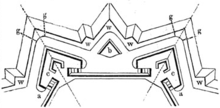Cavalier (fortress construction)
A cavalier , also known as a cat (e.g. bastion or curtain cat), is a cannon position that clearly towers above the neighboring plants for better control of the forecourt or the forecourt at tactical focal points. From the late 16th century, cavaliers were mostly built on bastions . As a rule, they are designed in such a way that they and the main wall could fire from the deck. In the New German Fortification also the name for defensive barracks behind front angles, which have a position on top of the wall (example: Ingolstadt ).
Occurrence
Fixed city
For the erection of a “cat” as a medieval defensive system in the rim of the city wall , a certain area on the inside up to the top of the wall was raised from the straight course of the city wall at the respective corners of the city. At the same time, the city wall got a head start ( flanking on the sides). The dimensions of such a cat cannot be read, approx. 200 m² can be assumed. But basically not every city that was surrounded by a medieval bering (city wall) had such cats.
After the renovation or expansion of a “fixed city” into a “fortress”, it looked very different with the cats. The definition says "bastions or curtains cat". These are terms from fortress terminology. In the medieval “fortified city” there were no bastions or curtains in the modern sense (from around 1500), and consequently no “bastions or curtain cats” either.
bastion
On top of a completed bastion , as part of a bastion front, there was another structure, the bastion cat (in the picture letter c). The area of a bastion cat as well as the bastion was standardized. The standard values refer to the corresponding Baumanier. That means: If there was enough space, the building was built according to the “regular” manner, i.e. with fixed length, width and height information. “Irregular” fortresses of the respective Baumanier had an area of approx. 300 m² for the bastion cat. Irregular means: as the topography dictated it. It had to be built smaller while keeping (as far as possible) the regular dimensions. According to the current French fortress language, the correct term for a bastion cat would then be the “cavalier”. The “cavalier” is therefore a real cat. Differences relate to the diverse construction of a fortress (New Italian, Old and New Dutch, Prussian as the corresponding basic construction).
See also
literature
- Hartwig Neumann : Fortress construction art and technology. German defense architecture from the XV. to XX. Century . Area, Erftstadt 2004, ISBN 3-89996-268-0 (EA 1988)
